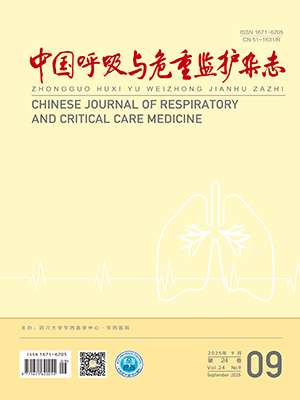| 1. |
Ksiazek TG , Erdman D , Goldsmith CS ,et al.A novel coronavirus associated with severe acute respiratory syndrome.N Engl J Med,2003,348:1953-1966.
|
| 2. |
Wong RS,Wu A,To K,et al.Haematological manifestations in patients with severe acute respiratory syndrome:retrospective analysis.BMJ,2003,326:1358-1362.
|
| 3. |
Ding Y,Wang H,Shen H,et al.The clinical pathology of severe acute respiratory syndrome (SARS):a report from China.J Pathol,2003,200:282-289.
|
| 4. |
Lang ZW,Zhang LJ,Zhang S,et al.A clinicopathological study of three cases of severe acute respiratory syndrome (SARS).Pathology,2003,35:526-531.
|
| 5. |
郑则广,陈荣昌,黎毅敏,等.严重急性呼吸综合征患者继发下呼吸道感染的队列分析.中国呼吸与危重监护杂志,2003,2:270-274.
|
| 6. |
Xu J,Zhong S,Liu J,et al.Detection of severe acute respiratory syndrome coronavirus in the brain:potential role of the chemokine mig in pathogenesis.Clin Infect Dis,2005,41:1089-1096.
|
| 7. |
Jiang Y , Xu J , Zhou C ,et al.Characterization of cytokine/chemokine profiles of severe acute respiratory syndrome.Am J Respir Crit Care Med,2005,171:850-857.
|
| 8. |
Tomura K,Narumi S.Differential induction of interferon (IFN)-inducible protein 10 following differentiation of a monocyte,macrophage cell lineage is related to the changes of nuclear proteins bound to IFN stimulus response element and kappaB sites.Int J Mol Med,1999,3:477-484.
|
| 9. |
Vockerodt M,Pinkert D,Smola-Hess S,et al.The Epstein-Barr virus oncoprotein latent membrane protein 1 induces expression of the chemokine IP-10:importance of mRNA half-life regulation.Int J Cancer,2005,114:598-605.
|
| 10. |
Dufour JH,Dziejman M,Liu MT,et al.IFN-g Inducible Protein 10 (IP-10;CXCL10)-Deficient Mice Reveal a Role for IP-10 in Effector T Cell Generation and Trafficking.J Immunol,2002,168:3195-3204.
|
| 11. |
Liu MT,Keirstead HS,Lane TE.Neutralization of the chemokine CXCL10 reduces inflammatory cell invasion and demyelination and improves neurological function in a viral model of multiple sclerosis.J Immunol,2001,167:4091-4097.
|
| 12. |
Rota PA,Oberste MS,Monroe SS,et al.Characterization of a novel coronavirus associated with severe acute respiratory syndrome.Science,2003,300:1394-1399.
|
| 13. |
Wang YD,Sin WY,Xu GB,et al.T-cell epitopes in severe acute respiratory syndrome (SARS) coronavirus spike protein elicit a specific T-cell immune response in patients who recover from SARS.J Virol,2004,78:5612-5618.
|
| 14. |
要国华,杨新艳,徐军.严重急性呼吸综合征冠状病毒S蛋白启动急性肺损伤的可能机制.医学研究生学报,2005,18:677-681.
|
| 15. |
李志杰,要国华,刘靖华,等.SARS冠状病毒S蛋白在昆虫细胞中的表达和纯化.病毒学报,2005,21:303-304.
|
| 16. |
Darnell JE,Kerr IM,Sark GM,et al.Jak-STAT pathways and transcriptional activation in response to IFNs and other extracelluar signaling proteins.Science,1994,264:1415-1421.
|
| 17. |
Hogan RJ , Gao G , Rowe T ,et al.Resolution of primary severe acute respiratory syndrome-associated coronavirus infection requires Stat1.J Virol,2004,78:11416-11421.
|
| 18. |
Lambert E , Boudot C , Kadri Z ,et al.Tissue inhibitor of metalloproteinases-1 signalling pathway leading to erythroid cell survival.Biochem J,2003,372:767-774.
|
| 19. |
Christen U , Benke D , Wolfe T ,et al.Cure of prediabetic mice by viral infections involves lymphocyte recruitment along an IP-10 gradient.J Clin Invest,2004,113:74-84.
|
| 20. |
Glass WG , Subbarao K , Murphy B ,et al.Mechanisms of host defense following severe acute respiratory syndrome-coronavirus (SARS-CoV) pulmonary infection of mice.J Immunol,2004,173:4030-4039.
|
| 21. |
Liu MT , Keirstead HS , Lane TE ,et al.Neutralization of the chemokine CXCL10 reduces inflammatory cell invasion and demyelination and improves neurological function in a viral model of multiple sclerosis.J Immunol,2001,167:4091-4097.
|
| 22. |
Sohn SJ , Forbush KA , Nguyen N ,et al.Requirement for Jak3 in mature T cells:its role in regulation of T cell homeostasis.J Immunol,1998,160:2130-2138.
|
| 23. |
Vincenti F.mmunosuppression minimization:current and future trends in transplant immunosuppression.J Am Soc Nephrol,2003,14:1940-1948.
|
| 24. |
Adams C , Aldous DJ , Amendola S ,et al.Mapping the kinase domain of janus kinase 3.Bioorg Med Chem Lett,2003,13:3105-3110.
|
| 25. |
Changelian PS , Flanagan ME , Ball DJ ,et al.Prevention of organ allograft rejection by a specific Janus kinase 3 inhibitor.Science,2003,302:875-878.
|
| 26. |
Chen RC,Tang XP,Tan SY,et al.Treatment of severe acute respiratory syndrome with glucosteroids:the Guangzhou experience.Chest,2006,129:1441-1452.
|




